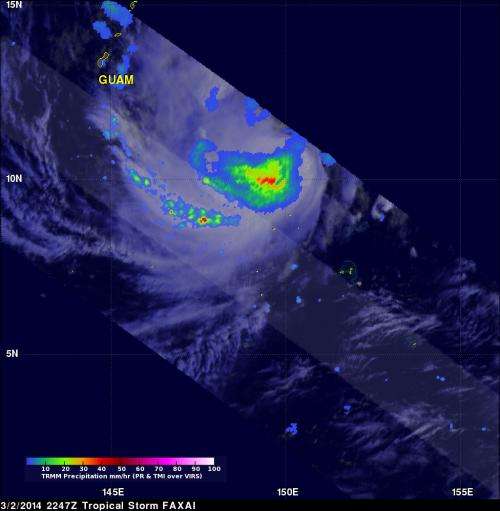TRMM satellite sees some towering thunderstorms around Faxai's center

Towering thunderstorms and heavy rainfall were occurring around the center of Tropical Storm Faxai in the Southwestern Pacific Ocean, and were seen by the TRMM satellite.
Tropical storm Faxai meandered in an area southeast of Guam for the past few days and is now predicted to move toward the north passing well to the east of Guam.
NASA and JAXA's Tropical Rainfall Measuring Mission satellite known as TRMM had a good daytime view of the tropical storm on March 2, 2247 UTC/5:47 p.m. EST. TRMM's Microwave Imager (TMI) and Precipitation Radar (PR) data revealed that Faxai had heavy rain falling at a rate of over 89 mm/~3.5 inches per hour). The TRMM image showed a few rain showers from Faxai were affecting Guam at the time.
At NASA's Goddard Space Flight Center in Greenbelt, Maryland, the TRMM satellite team used the data to create an image of the rate in which rain was falling.
On March 3, 2014 at 1500 UTC/10 a.m. EST, Faxai's maximum sustained winds were near 45 knots/51.7 mph/83.3 kph. Faxai was centered near 13.6 north and 149.9 east, about 294 nautical miles/338.3 miles/544.5 km east of Andersen Air Force Base, Guam.
MetOp-A microwave satellite imagery from today, March 3, confirms strong convection and developing thunderstorms persist around the center of circulation. MetOp-A is one in a series of three polar orbiting meteorological satellites that are managed by the European Organization for the Exploitation of Meteorological Satellites.
The Joint Typhoon Warning Center expects Faxai to move north, later northeast while it intensifies. In a couple of days, the storm is expected to become extra-tropical.
Provided by NASA's Goddard Space Flight Center




















